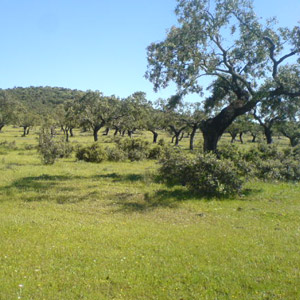Magazine | Voyages
Observer les oiseaux en Estrémadure

Vue de la dehesa, un paysage de forêt claire typique de la péninsule ibérique et en particulier de l’Estrémadure.
Photographie : Ornithomedia.com
Introduction
L’Estrémadure est une grande région espagnole peu connue bordant le Portugal, et l’une des plus riches au niveau ornithologique.
La dehesa, forêt claire de chênes au pied desquels paissent les taureaux, constitue l’habitat naturel typique de la région, et attire plusieurs espèces typiques comme l’Élanion blanc ou la Pie bleue. De petits massifs montagneux boisés, des zones steppiques et quelques barrages permettront à l’observateur d’allonger leur liste de manière substantielle.
André Boussard nous a transmis le rapport de son voyage réalisé du 25 au 30 avril 2003.
Abstract
The Extremadura is one of the biggest regions of Spain, and one of the most interesting regions in terms of wildlife and birds.
It occupies a small part of the Western section of the southern Meseta (central plateau). Much of the region is predominated by stock farming, a traditionnal activity that has ensured its remarkably good general state of conservation. Mediterranean dry grazing wood land (dehesa) still occupied vast areas. It comprises holm oak and cork oak, open woods with grazing land and ceral crops. This habitat attracts a rich wildlife, including Black-shouldered Kite, Great Spotted Cuckoo, Red-necked Nightjar, Azure-winged Magpie and Spanish Sparrow.
There are also small ranges, where the Extremadura birdlife is at best, with sites such as the Monfragüe National Park. In these areas, the gorges carved out by rivers are the breeding ground of cliff-dewelling species such as Black Stork, Griffon Vulture, Egyptian Vulture, Bonelli’s Eagle or Black Wheatear.
Patches of temperate woodlands are the habitat of very rare species like the Black Vulture, the Spanish Imperial Eagle, the Deer and the Spanish Lynx.
In some regions there are also deforestd plains, which are used by dry cereal growing and sheep grazing. These are the best areas for steppe-dwelling species in Western Europe, including Great Bustard and Sandgrouses.
Rivers, ponds, reservoirs and irrigated fields allow the birder to watch aquatic birds (Little Bittern, Herons, Ducks …).
In this article, André Boussard sent us the birding report of his trip done from the 25th to the 30th of April 2003.
Poursuivez la lecture de cet article, en vous abonnant dès maintenant !
Découvrez les Archives d’Ornithomedia.com
Pour seulement 10,00 €TTC/an (ou 6,00 € les 6 mois)
Profitez de plusieurs centaines d’articles en accès illimité et sans aucun engagement.
Compléments
Ouvrage recommandé
Where to Watch Birds in North & East Spain de Michael Rebane




Aucun commentaire sur ce sujet
Participer à la discussion !